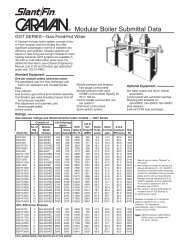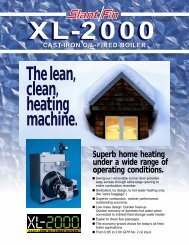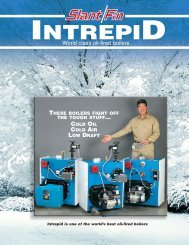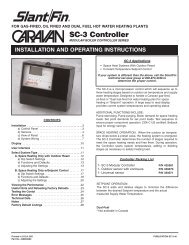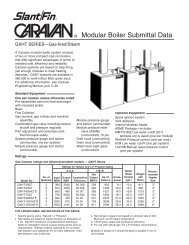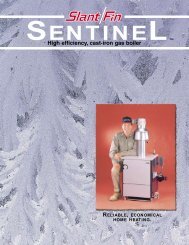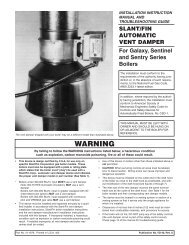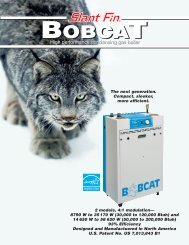Bobcat Boiler Display Board - Slant/Fin
Bobcat Boiler Display Board - Slant/Fin
Bobcat Boiler Display Board - Slant/Fin
Create successful ePaper yourself
Turn your PDF publications into a flip-book with our unique Google optimized e-Paper software.
3<br />
INSPECTION<br />
Your boiler and heating system will last an indefinitely long<br />
time at full efficiency, if it is inspected regularly and is kept<br />
in good repair and adjustment. You, the user, should make<br />
regular inspections, and report any problems to your<br />
service agency. At regular intervals, you should have that<br />
agency inspect the system and make repair adjustments<br />
as necessary. What you and the service agency should do<br />
is listed below. Contact your gas supplier for a list of qualified<br />
service and repair agencies.<br />
USER INSPECTION<br />
The user should make the following inspections at least<br />
once each month during the heating season and once<br />
just before cold weather starts. <strong>Bobcat</strong> B-120 and B-200<br />
boilers may be installed and vented either as direct-vent<br />
boiler, which all air for combustion is obtained directly<br />
from outside through the air intake piping or as nondirect-vent<br />
boiler, which all air for combustion is taken<br />
from inside the boiler room. Typical direct-vent installations<br />
are shown on Figures 2 and 3. Non-direct-vent<br />
installation is shown on Figures 4, 5 and 6.<br />
<strong>Bobcat</strong> Model B-120 and B-200<br />
1. VENTING AND AIR INTAKE SYSTEM REGULAR<br />
INSPECTION<br />
Inspect the system regularly for condensation, corrosion,<br />
sagging and/or physical damage. A qualified professional<br />
should service the boiler annually and include such an<br />
inspection at that time. The homeowner should look over<br />
the system monthly for damage, water stains, any signs of<br />
rust, other corrosions or separation of the vent and air<br />
intake piping (if direct-vent).<br />
Should an inspection turn up signs of condensation,<br />
corrosion, sagging or damage, the boiler should be shut<br />
down immediately and the condition should be corrected<br />
by a qualified professional.<br />
If the boiler is vented horizontally through the wall, the<br />
outside termination, louvers and screen should be checked<br />
for any debris blocking the opening and cleaned as<br />
required.<br />
Figure 2. Direct vent, sidewall venting illustration. Figure 3. Direct vent, venting and air intake<br />
through a roof.



